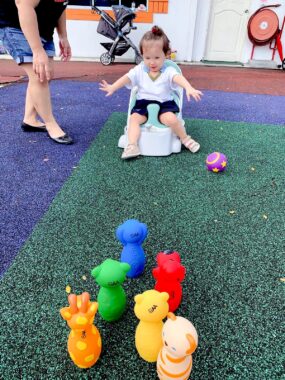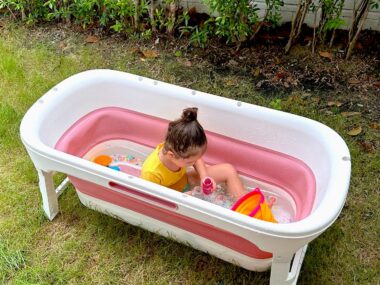How to improve bathing for children with AADC deficiency
Whether we use a tub or a shower, our goals are cleanliness and beyond
Written by |

Warm water flows across our child’s scalp and soothes her. Other times, the water tickles her and makes her feel anxious. Over time, these observations supported us in making her bathing experience pleasant.
Children with aromatic l-amino decarboxylase (AADC) deficiency will have severe symptoms such as hypotonia, which leaves them with low muscle tone, unable to stand or move. They’re highly dependent on others.
Our daughter, Rylae-Ann, was born with AADC deficiency. She was unable to sit, move, or talk, making her imprisoned in her body. After gene therapy, her movement was restored, but she still required assistance. Today she’s semi-independent, as you’d expect a young child to be.
The journey to better bathing is a team effort by my wife, Judy, and me. Each occasion had two goals: first, to make sure our daughter is clean; second, to use the opportunity for occupational therapy. Later we also combined sensory integration.
This combined approach led to our daughter making progress. It wasn’t always easy. Applying what we observed helped improve our daughter’s experience and our care for her.

Rylae-Ann enjoys bathing independently. (Photo by Richard E. Poulin III)
Location
A bathtub is rare in Asia, where we live; houses tend to have showers. When we travel to America, we use tubs, so we’ve gained experience with both. Given the option, I prefer to bathe Rylae-Ann using a shower, but my wife likes the tub.
Either way you choose, you’ll face advantages and disadvantages. If you find one location that works best, stick with it. Bathing happens daily, so you have a class every day.
All our bathrooms at home in Bangkok have showers and no tubs, so Judy bought an affordable plastic pink tub for the bathroom in our daughter’s room. Even better, the tub can easily be moved outside for water play there.
I use the downstairs shower, whereas Judy uses the upstairs bathroom. Here are the advantages and disadvantages we’ve found.
Shower
The shower allows for more movement and space, with a floor that’s flat and nonslip. Before Rylae-Ann had gene therapy, I had a supportive plastic sitting chair for her to use. After gene therapy, when she could stand independently, the plastic chair was for me, silly as that might appear.
Before gene therapy, she used different sitting devices that helped her progress to standing independently. After gene therapy, she could practice standing and grabbing bottles every day.
Our showerhead is attached to a hose, which lets me point the water where necessary. That’s better than with a fixed showerhead, where getting the water where you need it can be problematic. Still, I often wear a bathing suit because chances are, I’ll get wet, too.
In Bangkok, it’s warm year-round, but even then, a shower can make our daughter feel cold. When we showered in Taiwan during winter, we added a space heater in the bathroom to fight the cold.
Finally, the shower was a more elevated sensory experience for her. Depending on the water pressure and the stream type, the water might be too hard or come out in a stream that tickled her skin. We used an adjustable showerhead at home to support her sensory processing issues.

Rylae-Ann uses her supportive sitting device outside to practice independence. She uses the device in the bathroom, too. (Photo by Richard E. Poulin III)
Bathtubs
Bathtubs allow your child to be submerged in warm water. When bath time ends, they can go straight to a comforting towel, ensuring they never feel chilled. Being surrounded by warm water always puts a relaxed face on our daughter. We even have used an unplanned bath to calm her when she’s had a tantrum.
Sitting in a chair outside the tub, Judy enjoys the time to nurture our daughter while staying in her regular clothes. She and Rylae-Ann sing songs, read books, and splash water together. It’s like circle time at school. With a scoop, my wife can direct water where she needs it, such as when she rinses shampoo from Rylae-Ann’s hair.
Bathtubs are generally not designed with special needs children in mind. Before Rylae-Ann had gene therapy, we had a curved plastic chair insert for tubs. After she had gene therapy, we still used a nonslip mat at the bottom of the tub.

Rylae-Ann’s bathtub can be used inside or outside for water play. (Photo by Richard E. Poulin III)
Commonalities
In a shower or tub, we always use specific soaps. All are tear-free, hypoallergenic formulas. As skilled as we’ve become, soap undoubtedly enters her eyes, which complicates the experience.
Many educational and fun toys are available for the shower or bathtub, helping the practice become a wonderful time for bonding. Since Judy and I are busy with full-time and part-time jobs, we’re fortunate to have this time with our daughter.
Judy sees the two experiences as working on different goals. Shower bathing focuses on gross motor skills; bathtub bathing focuses on fine motor skills. The most crucial factor is your child getting clean. Find out which environment works best for you both, then start adding to the experience.
Note: AADC News is strictly a news and information website about the disease. It does not provide medical advice, diagnosis, or treatment. This content is not intended to be a substitute for professional medical advice, diagnosis, or treatment. Always seek the advice of your physician or other qualified health provider with any questions you may have regarding a medical condition. Never disregard professional medical advice or delay in seeking it because of something you have read on this website. The opinions expressed in this column are not those of AADC News or its parent company, Bionews, and are intended to spark discussion about issues pertaining to aromatic l-amino acid decarboxylase deficiency.






Leave a comment
Fill in the required fields to post. Your email address will not be published.